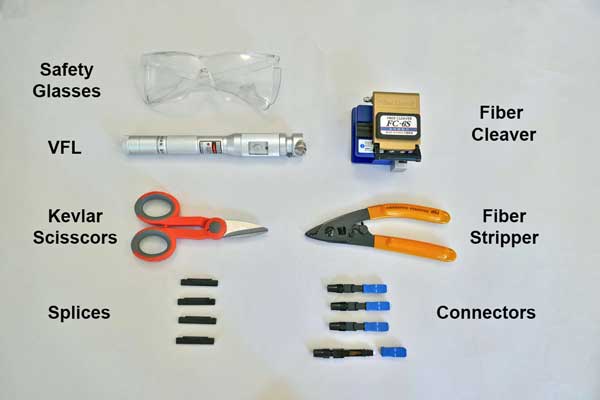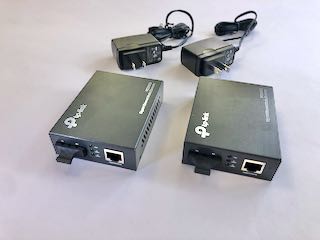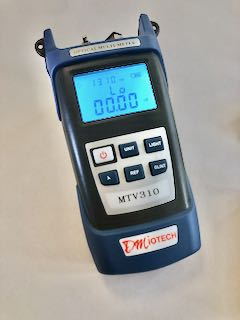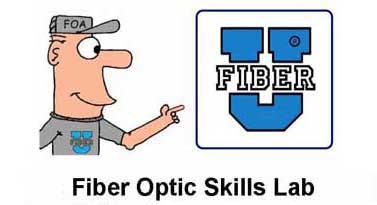Lesson: Fiber Optic
Skills Lab, Do
It Yourself
Level: Novice
Objectives:
From this lesson you should learn:
-
Where to purchase basic fiber optic tools and
components
- How
optical fiber transmits signals with light
- How
to perform basic fiber optic installation
processes: striping, cleaving, splicing,
terminating fiber
- How
to build a fiber optic link and test its
performance
Prerequisite
Before taking this course, you must first take the
Basic Fiber Optics
online course at Fiber U and get your Fiber U
Certificate of Completion.
Introduction
This is a basic skills lab for fiber optic
novices covering how fiber optic links and cable
plants work, cable preparation, splicing,
termination and testing. You will be directed to
watch some videos, perform some hands-on exercises
and work with some simulations.
The hands-on exercises are based on readily
available components and tools. You can purchase
the tools and components you need online
inexpensively and do the exercises yourself and/or
as part of an online class. The lesson will give
detailed directions based on the tools and
components listed below.
The
Lesson Steps
-
Obtain tools from school or purchase online
-
Follow exercises below
- If
part of an online course, you will demo what
you learned to your instructor on
videoconference
- You
may be asked to return the finished lessons
and tools to school
Acquiring
Tools And Components
This lesson uses the basic fiber optic tools and
components shown below. These tools and components
are readily available online at reasonable prices.
The total cost of tools if purchased from Amazon
or eBay should be under $100 and the two media
converters should be about $60. If you are
purchasing for yourself, the search terms for
Amazon, eBay, etc. are given as well as
approximate prices. If you are part of a class with
an FOA approved school, they may send you tools or
advise you to purchase them yourself.

Tools
(with online search terms if purchasing online)
- Fiber
stripper, 3 hole – 3mm/900micron/250micron
(fiber optic stripper 3 hole – ~ $12-15)
- Aramid
fiber scissors (fiber optic Kevlar Scissors –
~$5-10)
- Fiber
cleaver (fiber optic cleaver – approx. $20-25)
- Visual
Fault Locator – VFL (fiber optic visual fault
locator - ~$20-25)
- Alternative:
in searching you may find kits of the 3 tools
above plus other items you can use for other
exercises for ~$40-50 which is OK
- Black
vinyl work mat, ~2X3’, 0.5X0.8m (black vinyl
upholstery fabric, 1 yd, ~$5-10)

Components
(with online search terms)
- SM
cable, 3- 4ea (fiber optic patch cord SC to SC
duplex singlemode –3-5m length, ~$10-15ea)
- SC-SC
duplex mating adapters, 4 each
- Mechanical
splices (fiber optic mechanical splice, qty 5
or 10, ~$10-15)
- Splice
type connectors (fiber optic quick connector
singlemode, qty 10, ~$9-10)

Fiber Optic Media Converters
- 2
media converters (~$30 each) Fiber
optic media converters are used to create
fiber optic links. Two types are available,
those that operate over 2 fibers like most
fiber optic links and those that operate
over one fiber bidirectionally like fiber to
the home (FTTH) passive optical networks.
Exercises are provided for both types. If
you want to do both exercises you will need
2 pairs of media converters. See the exercise on
links for more details on them.
- Fiber
optic media converters - Ethernet input on Cat
5e cable to singlemode fiber - you will be
using singlemode fiber cables from the
installation exercises to connect them
- You
will connect them over fiber used in the
installation exercise
- Also
order two Cat 5e patchcords to connect your
electronics if you do not have any yourself

Fiber Optic Power Meter
- Used for testing
the link you will build
- Available online
(~$20-40)
Additional Equipment Required
- Safety
Glasses (hardware or drugstore, ~$5)
- Cleaning
supplies (alcohol and wipes)
- Fiber
disposal bin (Paper cup with lid, marked
"Fiber Scraps")
Lessons and Exercises
The following lessons and exercises are
included in this course.
Safety - Read information below before beginning
any exercises.
How fiber optics works and transmits information
Basic fiber optic cable handling
Fiber optic splicing and termination
- Stripping
fiber optic cables
- Cleaving
fibers
- Splicing
fibers with a mechanical splice
- Terminating
fibers with a prepolished/splice connector
Testing
- Visual
tracing and fault location
- Microscope
inspection of connectors
- Loss
testing
For each exercise you complete, fill in a
scorecard to document your results. Download Scorecards (PDF).
When you complete all exercises, you can get a Fiber U Certificate of
Completion.
Safety:
 |
Please Note:
This is not the usual online
course - it is intended to guide
you as you learn some of the basic
skills used in fiber optics. It
involves using actual tools and
components in a realistic manner.
Some of the processes here can be
hazardous, like working with sharp
scraps of optical fiber and
chemicals.
Always wear
safety glasses when doing any of
these exercises and dispose of all
fiber scraps immediately and
properly.
Do not
look directly into the light from the
visual fault locator - it's bright!
|
These guidelines are strictly
the opinion of the FOA provided for
educational purposes and the reader is
expected to use them as a basis for
learning. The FOA assumes no liability
for the use of any of this material.
Familiarize
yourself with these safety procedures and follow
them all the time. Watch FOA
Lecture 2: Safety When Working With Fiber
Optics or read
Online
FOA Guide: Fiber Optic Safety
Do not work with fiber without safety
glasses and a proper work area that is easy to
clean up.
We recommend working on a black vinyl mat to
make it easier to see the fiber (and any
scraps). It is best to work on tile or
concrete floors, not carpet. If you drop fiber
scraps into carpet they can be very hard to
find or pick up with a vacuum cleaner. Place
clean paper over your work area to keep from
harming the worktable surface.
Safety glasses must always be worn. Use
them, keep them clean, and protect them from
damage like any other tool. Always wear safety
glasses because you will generate fiber scraps
that may fly through the air and land anywhere. If
scraps get into your eye, you will be making a
visit to the local hospital emergency room. Do not allow
others to watch you work unless they wear safety
glasses also. Fiber scraps can fly a long
way!

X-ray of fiber shard in finger
The broken or cleaved ends of fibers are
extremely sharp and can easily penetrate your
skin! Be careful to not stick the broken
ends into your fingers, since they invariably
break off and are very hard to find and remove.
Most times, you have to wait for them to infect
and painfully work themselves out.
Avoid these accidents by exercising a little
caution. Dispose of all scraps immediately and
properly. Put them in a properly marked
paper cup or other container for disposal. Do not
drop them on the floor where they will stick in
carpets or shoes and be carried elsewhere. Do not
eat anywhere near the work area.
Clean up after your exercises carefully.
Video:
FOA
Lecture 2: Safety When Working With Fiber
Optics Online
FOA Guide: Fiber
Optic Safety
Lessons
and Exercises
Click on the links for each exercise. Download
the Scorecards to keep records
of your completion of each exercise.
Safety Rules - Read before
beginning any exercises (above)
1. How Fiber Optics Works (hands-on, one
exercise)
2. Basic fiber optic cable handling and
preparation (watch 3 FOA YouTube videos)
3. Fiber optic splicing and termination (hands-on,
4 exercises) These exercises need to be completed
in this order as each of them are dependent on the
prior exercise.
4. Testing
5. Fiber Optic Links
When you complete all exercises, you can get a
Fiber U Certificate of Completion.
If you have watched all the videos,
used the loss simulator and successfully completed
all the hands-on exercises required you may take
this Fiber U Certificate of Completion exam.
If you are taking this course yourself, the Fiber U
Certificate of Completion exam cost
$20. Go here to pay and take the
exam.
If you are taking this course with an
instructor from an FOA Approved school, they
will provide the link for you to take the
exam.
This information
is provided by The Fiber Optic Association, Inc.
as a benefit to those interested in teaching,
designing, manufacturing, selling, installing or
using fiber optic communications systems or
networks. It is intended to be used as an
overview and/or basic guidelines and in no way
should be considered to be complete or
comprehensive. These guidelines are strictly the
opinion of the FOA and the reader is expected to
use them as a basis for learning, as a reference
and for creating their own documentation,
project specifications, etc. Those working with
fiber optics in the classroom, laboratory or
field should follow all safety rules carefully.
The FOA assumes no liability for the use of any
of this material.
|

